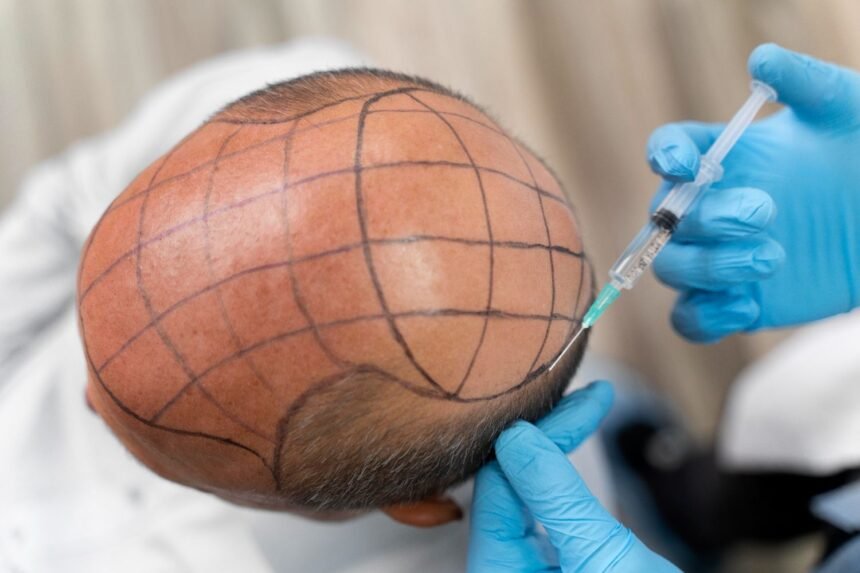Relax, hair loss after a hair transplant is common, it’s normal. It’s a healing process and it’s temporary, but we should know the Hair Transplant Side Effects. Now, why it happens? It’s called shock loss. Yeah, it’s a shock for the hair follicles. The trauma they got during the transplant temporarily cuts off the blood supply to the follicles. They shed the hair and eventually produce new hair, stronger and healthier. Say, it’s the scalp’s way of adjusting to the new follicles.
But how can you keep this hair fall in check?
Here’s how you can support your scalp as it recovers and minimise further hair fall. Keep these tips in mind, and your hair will thank you!
- Gentle Care is Key: The follicles are fragile. Avoid tugging, pulling, or scratching the transplanted area. Treat that area like royalty to help the follicles settle in.
- Skip the Heat Styling: Hairdryers and straighteners can stress your scalp, slowing down recovery. Let your hair air dry instead!
- Diet: Doctor-recommended medications, essentially protein, vitamins, and minerals. Fill in healthy greens, nuts, and lean proteins.
- Shampoos: Again, your dermatologist can recommend a medicated shampoo to avoid scalp irritation or you can ask for a mild sulfate-free shampoo.
Hair Transplant Gone Wrong: Common Mistakes and How to Avoid Them
Hair transplants are a big step, and the results can be life-changing, yet there’s a fine line between fantastic results and okay results. If the Hair Transplant Gone Wrong, the Common mistakes can make all the difference. They’re totally avoidable with the right approach!
- Rushing the Process: Haste makes waste! Quick, cheap, or unqualified clinics might not follow the necessary protocols, leading to disappointing results. Avoid rushing the decision and do your homework on licensed clinics.
- Ignoring Post-Op Instructions: Your surgeon’s instructions are like gold—follow them! Ignoring these rules, like skipping post-op care or smoking too soon after the procedure, can impact your results.
- Skipping on Quality: High-quality transplants require expertise, good-quality follicles, and the right techniques. Avoid clinics that promise quick-fix solutions at suspiciously low prices.
- Overestimating the Outcome: While hair transplants can be transformative, remember that results can vary depending on individual factors like hair type and growth patterns.
- Unrealistic Timeline Expectations:
Hair transplants require time to show full results. Expecting immediate, dense growth within weeks can lead to disappointment. Patience is crucial as results typically emerge over several months.
To avoid these pitfalls, aim for professional and personalised care, where the focus is on understanding your unique hair growth and providing a lush, beautiful result—minus the mistakes!
Long-Term Side Effects of Hair Transplant : What No One Tells You About the Future!
The excitement of a successful hair transplant can often make you overlook the long game. And yes, while transplants can offer amazing results, there are a few Long-Term Side Effects of Hair Transplant that often go unmentioned:
- Thinning Over Time: While transplants are designed to last, the surrounding natural hair may thin out with age, which can lead to gaps over time.
- Scarring: Even with advanced techniques, some people may develop small scars that remain visible if they decide to shave their heads or wear certain hairstyles.
- Hair Texture Changes: Transplanted hair can sometimes have a different texture from your natural hair. This might mean styling adjustments, especially if you have curly or coarse hair.
- The Need for Touch-Ups: Transplanted hair doesn’t stop the ageing process of your scalp. This means that additional treatments may be needed over time to maintain the original density.
Long-term results are best achieved with a holistic approach. Get expert advice on maintaining, restoring, and caring for your new look so it stays fresh, healthy, and natural for years to come.
Is Hair Transplant Painful? Know the Pain and Recovery Process
Yes and No, it’s best defined as discomfort rather than pain. It might be easy for ladies who do waxing. Doctors do take the right care and expertise to make the process worthwhile.
- During the Procedure: Most transplants are done under local anaesthesia. You’ll feel little to no pain. Think of it as a numb feeling that lets you stay calm and comfortable throughout.
- Post-Procedure Soreness: You might feel sore and see swelling in the transplant area. It’s normal and should subside in a few days.
- Itching and Mild Discomfort: With healing comes mild itching. It’s tempting, but avoid scratching to protect those new follicles!
- Pain Management: Most clinics will prescribe pain relievers to manage any discomfort during the healing period, so the recovery process remains smooth and stress-free.
Glamifix Secret to Gorgeous Hair! Knows Better to Avoid Hair Transplant Side Effects
The best hair care? It’s often about prevention rather than correction. That’s where Glamifix shines. Expert Help, Real Results. Glamifix’s top-notch dermatologists and hair specialists know the tricks to make your hair healthier and fuller.
- Using growth factors from your own blood, we revitalise your scalp to promote natural hair growth. Healthier hair, right from your roots!
- Using the power of your platelets, plasma strengthens and thickens your hair—perfect for a lush, fuller look that’s all your own.
- Directly deliver vitamins, minerals, and amino acids to the scalp to boost circulation and strengthen hair follicles.
Customised Solutions, Just for You. At Glamifix, it’s all about understanding your unique hair and scalp needs. They get to the root of the problem, leaving you with long-term, confidence-boosting results. Why wait for a problem when you can have lush, healthy hair now? Glamifix is all about prevention over surgery, helping you keep that gorgeous hair naturally.

Leave a Reply